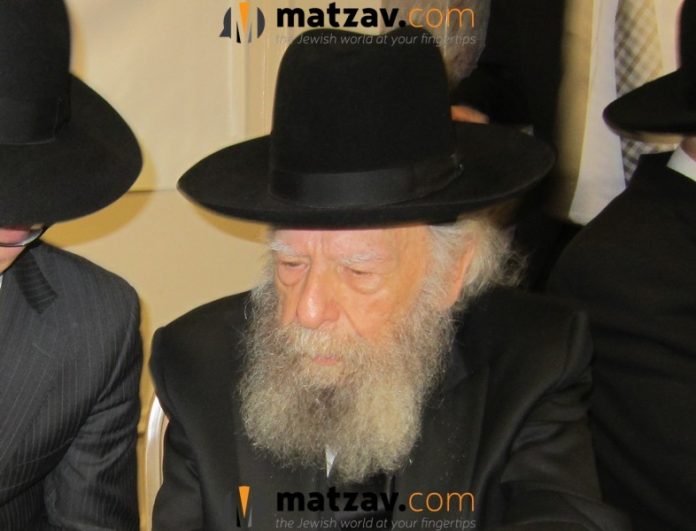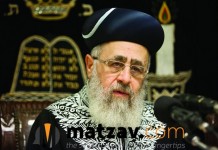
It is with great sadness that Matzav.com reports the passing of Rabbi Shimon Segal zt”l, menahel klali of Yeshiva Toras Emes for over 60 years. He was 95 years old.
The European-born Rabbi Segal survived the difficult war years, including spending time in the Kovno Ghetto, which was established by the Nazis to hold Lithuanian Jews during the Holocaust. At its peak, the ghetto housed 29,000 people, Jews who had survived initial pogroms. Most were later sent to concentration and extermination camps.
Rabbi Segal maintained a close bond with, among other gedolei Torah, Rav Mordechai Pogramansky, one of the Torah giants of Lithuania.
After the war, Rabbi Segal first spent time in France with Rav Pogramansky. He later immigrated to the United States.
Rabbi Segal was greatly involved in acts of askanus both in the United States and Eretz Yisroel, where he was close to gedolei Torah and would assist yechidim and mosdos in many ways.
For many years, Rabbi Segal shepherded Yeshiva Toras Emes-Kamenitz in Boro Park, where it was led by the rosh yeshiva, Rav Levi Krupenia. The yeshiva was previously in Woodridge, NY, where it flourished, becoming one of the leading mekomos haTorah in America, before moving to Boro Park upon the completion of the new Toras Emes Kamenitz campus in 1973.
Later, the yeshiva moved to Flatbush, where it is located today.
While Rav Shimon did not merit biological children, he was “adopted” by the Zelinger family, who he treated like his very own.
Rav Shimon leaves behind a legacy of fortitude and perseverance demonstrated during daunting nisyonos in Europe, and decades of devotion to chinuch habonim and harbotzas Torah at the mosad he led and was so devoted to.
The levayah will take place tomorrow, Monday, at 11 a.m. at Yeshiva and Mesivta Toras Emes, located at 1904 Avenue N in Brooklyn, NY. There will be no hespeidim. The aron will then be flown to Eretz Yisroel for kevurah there.
Yehi zichro boruch.
{CB Frommer-Matzav.com}












Why do you tell us after they die that they existed?? Why can you not put together a list of all of these yidden, the last remaining link to the previous world, so that we can go and visit with them, and that talk to them, so that our children can actually see them… Not just pictures of them after they pass…
Chanan – good question.
One/part of the answer I suspect is that not all would welcome that. They might be be/feel overwhelmed if all of a sudden people are lining up to talk to them. They might prefer not to do so for reasons of modesty, tznius, חשש עין הרע, וכו.
They might feel undeserving, or suspicious of their sudden celebrity after so many years.
Just like some churban survivors are reluctant to speak about what they went through so long ago, so too in some of these cases, even if they didn’t go through all the horrors of the WWII era (interestingly, a similar thing exists among some war veterans in general, e.g. a Notzri WWII veteran who went through heavy fighting in Europe, the Pacific, Vietnam, etc., might not want to talk about due to it being traumatic, recalling friends that fell then, feelings of ‘survivor guilt’, feelings that people nowadays would not understand, etc.).
Chananya:
There were many people that knew him, knew of him, and were close to Rabbi Segal. He most definitely would not have enjoyed the limelight.
Yehi zichro boruch.
“The European-born Rabbi Segal survived the difficult war years, including spending time in the Kovno Ghetto”
I recall a write up years ago in the אלגעמיינער זשורנאל about Rabbi Segal and his chaver Rabbi Meir Lampert z”l (administrator of Yeshiva Toras Emes – YTEK in Borough Park years ago, and Rav of the Yeshiva Shul on 43rd street) in the ghetto during the war, by the late writer Nisson Gordon, IIRC.
“Rabbi Segal maintained a close bond with, among other gedolei Torah, Rav Mordechai Pogramansky, one of the Torah giants of Lithuania.”
One can see much related to that in the sefer on R. Mottel Pogremansky z”l published a few years ago, edited by Rav Dov Eliach shlit”a (an English version came out more recently, entitled “The Man Who Never Slept – The Challenges and Triumphs of R. Mordechai Pegrimansky”), to which R. Segal z”l contributed very significantly.
Boruch dayan emes.
He was at Yeshiva Toras Emes events many times over the years, most recently at the brunch just a couple of weeks ago, and he was always treated with well-deserved kavod by the talmidim and hanhallah alike.
Chanan:
There were many, many people that knew him, knew of him, and all about him. Virtually ALL would say that he would’ve eschewed the limelight. (As many of his kind would as well)
As one of his thousands upon thousands of children (Talmidim) that learned in MYTEK, we really should learn mishnayos l’zecher nishmaso.
Yehi zichro boruch.